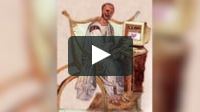A. The General Task and Aim
The Augustinus-Lexikon deals in alphabetical order with concepts, persons, places, institutions, and objects which are of importance for Augustine’s life, work, and teaching. The broad scope of its presentation takes not merely Augustine’s biography and writings into account, but also treats of his position in Church politics, the personalities of his milieu, as well as the contemporary context. The enormous extent of Augustine’s influence, as well as the fact that much scholarly work remains to be done on it, mean that the history of his importance for posterity is excluded.
I. External Form
The Augustinus-Lexikon will consist of five volumes of text and an index volume.
The articles are preceded by lists of Augustine’s works and of the abbreviations used.
The Lexikon employs subject-titles in Latin only, derived from Augustine’s writings, thereby guaranteeing as great a degree of interpretative authenticity as possible.
The Lexikon contains about 1.200 subject-titles. Some articles of wide-ranging scope and content are planned as general articles (e.g. Africa, Sacramentum), or, as miscellaneous articles, deal in summary fashion with persons of topics of lesser individual importance for Augustine, e.g. Imperatores Romani, Itinera (= Augustine’s travels), Scriptores graeci.
The articles will be published in German, English, or French. Articles written in other languages will be translated into one of these three languages, in consultation with the authors.
Important passages from Augustine will be quoted verbatim.
The current state of resaerch will be presented. Views at variance with those of the author will be reported. The bibliographies will contain the most important literature and, as far as possible, a complete list of the literature on Augustine that has appeared since 1970.
II. Contents
1. The volumes of text deal with:
a) Persons connected with Augustine: his family, friends, and pupils; his adversaries; the authors he read, especially those whose works are essentially transmitted through him, e.g. Faustus, Pelagius, Julian of Eclanum; important contemporaries.
b) Places, objects, and data of social, political, religious, and cultural significance. Archeological and topographical data will be treated under the appropriate headings, such as e.g. Baptisterium, Hippo Regius, etc.
c) Writings of Augustine. Letters and sermons will be dealt with in general articles, except for those which Augustine himself included among his individual works. Works whose authenticity is controversial will be also treated in individual articles.
d) Concepts which are characteristic of Augustine’s thought. Their treatment takes both the Christian and classical traditions into account. Terms whose meanings are related will be treated under the dominant word: specific distinctions will be elucidated in the articles on the individual concepts (e.g. Amor, Caritas, Dilectio).
2. The index volume will contain:
a Latin index of the persons, objects, data, and concepts treated in the articles;
indexes in German, English, and French, which allow the Lexikon to be exploited from the point of view of modern questions in such fields as aesthetics, economics, ethics, Neoplatonism, politics, Semipelagianism, society, etc.;
lists of Greek terms, of the Augustine passages quoted, of Biblical passages and those from other ancient authors, of the contributors and the articles written by them.
B. The Composition of Individual Articles
The following aspects (‹structural guidelines›) apply in general in the composition of the four kinds of article:
I. Prosopography
1. Historical personalities:
a) biographical data with particulars of sources
b) characterization of the person
c) direct and indirect association with Augustine
d) literary activity of writers and their influence upon Augustine
2. Figures in salvation history:
a) pre-Augustinian tradition
b) exegesis in Augustine’s day
c) importance in Augustine’s works
II. Factual groupings
1. Topographical and archeological articles:
a) ancient and modern names
b) geographical situation and archeological findings
c) social, cultural, and political context
d) specific importance for Augustine
2. Articles on cult and liturgy:
a) literary and iconographical evidence
b) legal, institutional, and pastoral aspects
c) theological relevance for Augustine
3. Other factual groupings will be dealt with in similar manner.
III. Writings
1. Genuine writings
a) title and, where appropriate, variants
b) place and time of composition
c) structure, contents, and sources
d) parallels in Augustine and contemporary writers
e) reference to the manuscript tradition
2. Writings of disputed authenticity
a) treatment as in 1
b) discussion of the question of authenticity
IV. Concepts
a) survey of usage and meaning
b) history of the concept
d) range of significance in Augustine

